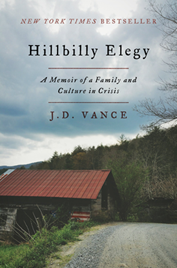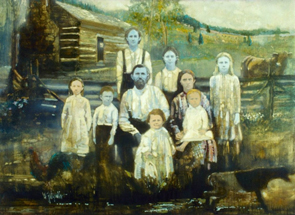There's nothing wrong with your color, being you,
he said firmly. Nothing wrong with what the good Lord gives us in His world, Cussy Mary.
He didn't know, couldn't know, the load I'd carried as a Blue, the scorn and hatred and gruesome marriage. How dare Pa call me vain and now Jackson. How dare he too? Nothing wrong—
Jackson repeated. I stepped back and shot out a shaky hand. No, Jackson Lovett, you're wrong. There is nothing wrong with your color in your world, a world that wants only whiteness.
This book combines two separate pieces of history into one satisfying story. The story revolves around the travelling Kentucky Pack Horse Library program, told from the perspective of one of the Pack Horse Librarians, or ‘Book Women’ as they were called. Our librarian is Cussy Mary Carter, the only child of a Kentucky coal miner. Cussy is also blue. Not blue as in depressed: she literally has blue skin. It was this point which initially caught my attention with this book, it just sounded so implausible that blue people actually existed. I had to resort to Google where I discovered the fascinating story of this group of people with the rare genetic condition of Methemoglobinemia. I've included some information on this subject in the sidebar.
The Pack Horse Library program was funded through President Roosevelt's New Deal and was essentially an educational program, as well as providing work for the librarians. Kentucky was one of the poorest areas in the US at the time this book is set - 1936, middle of the Depression - and had incredibly low literacy levels. The program aimed to provide books and other reading materials to isolated communities. Children benefitted from the program by having access to reading materials, to learn to read in the hope that they could break out of the cycle of poverty they were born into. And adults also benefitted, some learned to read, others who could read but who could not afford books gained access to things to read. Books and health pamphlets also helped introduce hygiene and medical practices to replace dangerous or unpalatable folk remedies, such as rubbing groundhog brains on a baby's sore teeth or drinking water from a stranger's shoe to cure thrush.
But despite all the benefits of the program, it had its detractors, people who did not approve. Cussy's own father thought it was more important for her to be married, even to an older, violent man who abused her, than to continue at her job, viewing work as a man's role, with a woman's role being to feed her family and stay respectable. He also thought her route was dangerous, and what she provided were 'dirty books', when all folk needed to be able to read was their Bible. Other people on her route viewed time their children spent reading as wasted. Time which could be spent doing chores. In a harsh world where many people were starving, everyone in a family had to work constantly to struggle to survive. Cussy many times had to pacify angry fathers by showing that the books she provided could teach a child how to tie knots properly, or how to fish, or how to perform their chores more effectively.
Added to Cussy's difficulties with suspicious hill-people was her additional problem of being a ‘blue’. The world of the Appalachia hill-people was deeply rigid: anyone who was different in any way was ostracised. Cussy is an intelligent, compassionate woman in stark contrast to the many illiterate white folk who shun her and treat her as sub-human. The more isolated people on her route are ultimately more accepting of Cussy's colour than the townsfolk, as they come to appreciate the human contact and kindness she brings, and the hope that she provides that there is something better the children in this world can strive for.
The first-person narrative of the book lets us see the world directly through Cussy's eyes. We know of her dreams and feel her fears directly. The story is a bit slow to get started, taking its time to build up a feeling for the isolated world of the hill-people and the harsh Appalachian landscape, and of the prejudices ingrained in the people. However, it builds up in intensity about halfway through, with the death of one character which leads indirectly to Cussy agreeing to medical tests to determine the cause of her blue skin.
As fascinating as the Pack Horse Library project is, it is the story of Cussy's blue skin which provides the strength to this story. The story explores bigotry and racial intolerance in an unusual setting. Racially, Cussy is Caucasian, but her unusual colouring sets her apart from the white people of the town. She is regarded as coloured and treated as an outcast. She is taunted or abused by many people and regarded with suspicion. While her fellow librarians are friendly, the bosses at the library treat her as sub-human. But throughout, Cussy remains strong and is happy to have found a job that she loves, a job which she believes is important to her patrons.
A local doctor has been fascinated by the blue family for many years, but has never been able to persuade them to allow him to take blood samples for study. However, when an unfortunate accident results in a death, it puts the family in his power, and he uses this position to finally take Cussy to a hospital in a nearby city for medical tests. As Cussy's father puts it when she protests that that they are both innocent of any wrongdoing, Blues don't have to do much, Cussy … Blues and many a colored have been hanged for less.
The tests ultimately lead to the discovery that Cussy and her father have methemoglobinemia, a rare genetic blood disorder which results in their blood not being oxygenated, leading to the appearance of blue skin. He provides a 'cure' for the blueness, taking doses of methylene blue which adds oxygen to the blood and removes the blue appearance. This cure is short term only, and the blueness returns if the treatment stops. Cussy takes her treatment each day despite its side-effects of headaches and vomiting, and is thrilled at first to become white. But her joy is short-lived when she realises that she is still not accepted by the townspeople and is regarded with even more suspicion that her changed colour is due to a sickness which will infect them, a fact her father had already realised:
Those that can't see past a folk's skin color have a hard difference in them. There's a fire in that difference. And when they see you, they'll still see a Blue. No city drug's gonna change small minds, what they think about peculiarity. For them like-minded folks, there is no redemption for our kind.
This was a fascinating book to read, with a strong and sympathetic main character. It really gave a feel for the severity of the Appalachian world, for the isolation of the hill-people who lived so close to more civilised areas but were far removed from them, and for the conditions in the Kentucky coal mines where the exploitative mine owners forced their miners to work in unsafe conditions, underpaid the miners, and paid them only in company script, redeemable only in company stores. My only criticism of the novel is the abrupt and violent ending to the story, followed by an epilogue which seemed to me to be a clumsy form of exposition. I admit I wanted a happy ending for Cussy, after all she endured during the course of the story, however, I have to admit that the ending was undoubtedly more realistic for the time than a happy ending would have been. But I think the book should have simply ended without the clumsy expository letter at the end. Just a small quibble, and one that doesn't change my enjoyment of this book. Recommended.
Related Book Reviewed on this Website:

 RSS Feed
RSS Feed Facebook
Facebook Instagram
Instagram YouTube
YouTube Subscribe to our Newsletter
Subscribe to our Newsletter





No one has commented yet. Be the first!